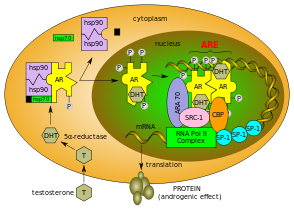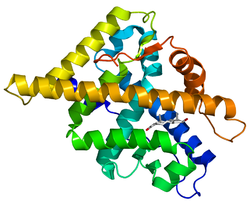| Androgen_recep | |||||||||
|---|---|---|---|---|---|---|---|---|---|
 crystal structure of the human androgen receptor ligand binding domain bound with an androgen receptor nh2-terminal peptide, ar20-30, and r1881 | |||||||||
| Identifiers | |||||||||
| Symbol | Androgen_recep | ||||||||
| Pfam | PF02166 | ||||||||
| InterPro | IPR001103 | ||||||||
| |||||||||

The androgen receptor (AR), also known as NR3C4 (nuclear receptor subfamily 3, group C, member 4), is a type of nuclear receptor[9] that is activated by binding any of the androgenic hormones, including testosterone and dihydrotestosterone,[10] in the cytoplasm and then translocating into the nucleus. The androgen receptor is most closely related to the progesterone receptor, and progestins in higher dosages can block the androgen receptor.[11][12]
The main function of the androgen receptor is as a DNA-binding transcription factor that regulates gene expression;[13] however, the androgen receptor has other functions as well.[14] Androgen-regulated genes are critical for the development and maintenance of the male sexual phenotype.
- ^ a b c GRCh38: Ensembl release 89: ENSG00000169083 – Ensembl, May 2017
- ^ a b c GRCm38: Ensembl release 89: ENSMUSG00000046532 – Ensembl, May 2017
- ^ "Human PubMed Reference:". National Center for Biotechnology Information, U.S. National Library of Medicine.
- ^ "Mouse PubMed Reference:". National Center for Biotechnology Information, U.S. National Library of Medicine.
- ^ Quigley CA, De Bellis A, Marschke KB, el-Awady MK, Wilson EM, French FS (June 1995). "Androgen receptor defects: historical, clinical, and molecular perspectives". Endocrine Reviews. 16 (3): 271–321. doi:10.1210/edrv-16-3-271. PMID 7671849.
- ^ Gottlieb B, Lombroso R, Beitel LK, Trifiro MA (January 2005). "Molecular pathology of the androgen receptor in male (in)fertility". Reproductive Biomedicine Online. 10 (1): 42–8. doi:10.1016/S1472-6483(10)60802-4. PMID 15705293.
- ^ Choong CS, Wilson EM (December 1998). "Trinucleotide repeats in the human androgen receptor: a molecular basis for disease". Journal of Molecular Endocrinology. 21 (3): 235–57. doi:10.1677/jme.0.0210235. PMID 9845666.
- ^ Meehan KL, Sadar MD (May 2003). "Androgens and androgen receptor in prostate and ovarian malignancies". Frontiers in Bioscience. 8 (1–3): d780–800. doi:10.2741/1063. PMID 12700055.
- ^ Lu NZ, Wardell SE, Burnstein KL, Defranco D, Fuller PJ, Giguere V, et al. (December 2006). "International Union of Pharmacology. LXV. The pharmacology and classification of the nuclear receptor superfamily: glucocorticoid, mineralocorticoid, progesterone, and androgen receptors". Pharmacological Reviews. 58 (4): 782–97. doi:10.1124/pr.58.4.9. PMID 17132855. S2CID 28626145.
- ^ Roy AK, Lavrovsky Y, Song CS, Chen S, Jung MH, Velu NK, et al. (1999). Regulation of androgen action. Vitamins & Hormones. Vol. 55. Elsevier. pp. 309–52. doi:10.1016/S0083-6729(08)60938-3. ISBN 978-0-12-709855-5. PMID 9949684.
- ^ Bardin CW, Brown T, Isomaa VV, Jänne OA (1983). "Progestins can mimic, inhibit and potentiate the actions of androgens". Pharmacology & Therapeutics. 23 (3): 443–59. doi:10.1016/0163-7258(83)90023-2. PMID 6371845.
- ^ Raudrant D, Rabe T (2003). "Progestogens with antiandrogenic properties". Drugs. 63 (5): 463–92. doi:10.2165/00003495-200363050-00003. PMID 12600226. S2CID 28436828.
- ^ Mooradian AD, Morley JE, Korenman SG (February 1987). "Biological actions of androgens". Endocrine Reviews. 8 (1): 1–28. doi:10.1210/edrv-8-1-1. PMID 3549275.
- ^ Heinlein CA, Chang C (October 2002). "The roles of androgen receptors and androgen-binding proteins in nongenomic androgen actions". Molecular Endocrinology. 16 (10): 2181–7. doi:10.1210/me.2002-0070. PMID 12351684.






